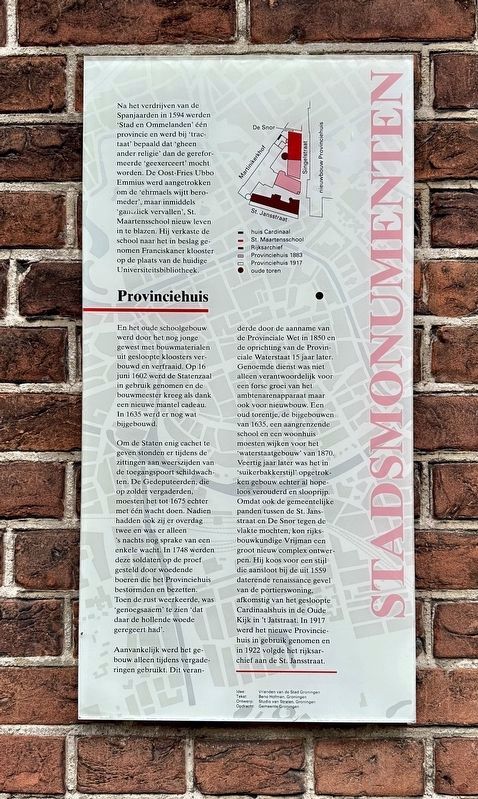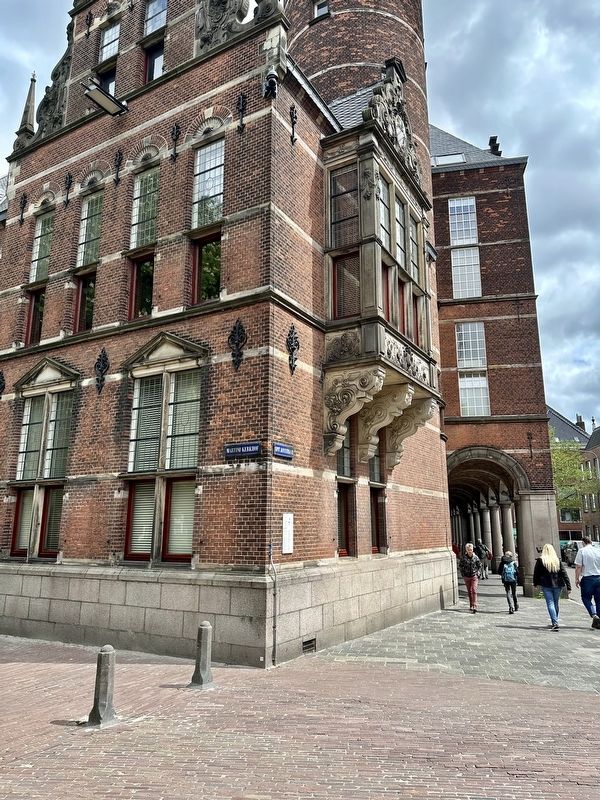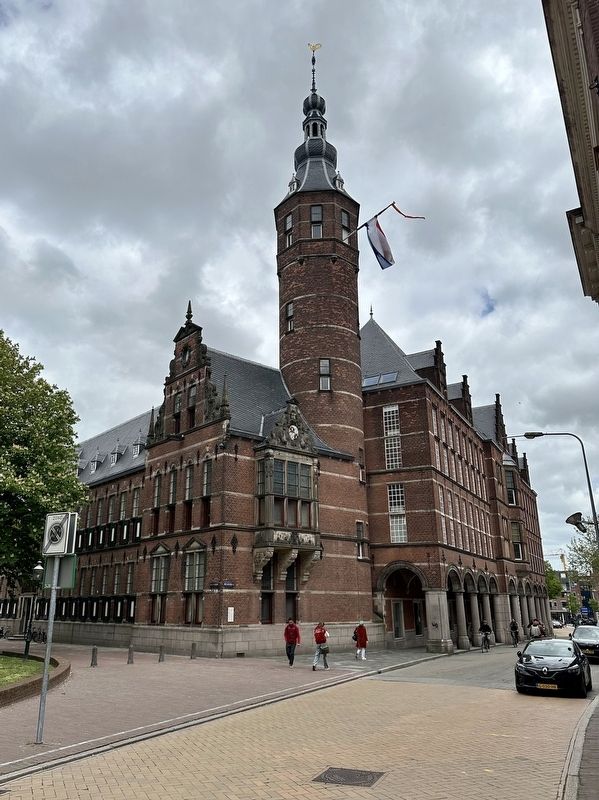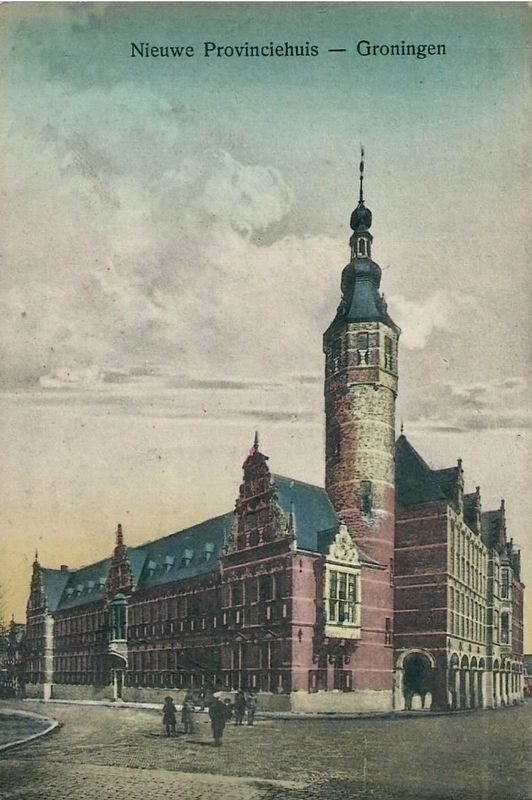Groningen, Netherlands — Northwestern Europe
Provinciehuis / Provincial House
— Stadsmonumenten —
En het oude schoolgebouw werd door het nog jonge gewest met bouwmaterialen uit gesloopte kloosters verbouwd en verfraaid. Op 16 juni 1602 werd de Statenzaal in gebruik genomen en de bouwmeester kreeg als dank een nieuwe mantel cadeau. In 1635 werd er nog wat bijgebouwd.
Om de Staten enig cachet te geven stonden er tijdens de zittingen aan weerszijden van de toegangspoort schildwachten. De Gedeputeerden, die op zolder vergaderden, moesten het tot 1675 echter met één wacht doen. Nadien hadden ook zij er overdag twee en was er alleen ’s nachts nog sprake van een enkele wacht. In 1748 werden deze soldaten op de proef gesteld door woedende boeren die het Provinciehuis bestormden en bezetten. Toen de rust weerkeerde, was ‘genoegsaaem’ te zien ‘dat daar de hollende woede geregeerd had’.
Aanvankelijk werd het gebouw alleen tijdens vergaderingen gebruikt. Dit veranderde door de aanname van de Provinciale Wet in 1850 en de oprichting van de Provinciale Waterstaat vijftien jaar later. Genoemde dienst was niet alleen verantwoordelijk voor een forse groei van het ambtenarenapparaat maar ook voor nieuwbouw. Een oud torentje, de bijgebouwen van 1635, een aangrenzende school en een woonhuis moesten wijken voor het ‘waterstaatgebouw’ van 1870. Veertig jaar later was het in ‘suikerbakkerstijl’ opgetrokken gebouw echter al hopeloos verouderd en slooprijp. Omdat ook de gemeentelijke panden tussen de St. Jans-straat en De Snor tegen de vlakte mochten, kon rijks-bouwkundige Vrijman een groot nieuw complex ontwerpen. Hij koos voor een stijl die aansloot bij de uit 1559 daterende renaissancegevel van de portierswoning, afkomstig van het gesloopte Cardinaalshuis in de Oude Kijk in ‘t Jatstraat. In 1917 werd het nieuwe Provinciehuis in gebruik genomen en in 1922 volgde het rijksarchief aan de St. Jansstraat.
After the Spaniards were driven back in 1594, the city and the surrounding country side, called the Ommelanden, became one province.
It was decided by decree that no other religion than the reformed church was to be professed. The East Frisian Ubbo Emmius was appointed to revive the renowned but now dilapidated St. Maartensschool. He moved the school to the seized Franciscan monastery, which stood, on the site of the present University library.
The old school was rebuilt and decorated by the new province with building materials from demolished monasteries. The State Hall was put into use on June 16, 1602, and the architect received a new coat as a gift. In 1635 some more extension were built. To give the states some cachet during the meetings, sentries stood on both sides of the entrance gate. The Deputies, which met in the attic, had to make do with only one sentry until 1675. Afterward, they also had two and only at night they had to make do with a single guard. In 1748 these soldiers were challenged by angry farmers who stormed the county hall and occupied it. When the peace returned a galloping fur was said to have gone through the building.
Initially, the building was only used during meetings. This changed with the adoption of the Provincial Law in 1850, and the establishment of the Provincial public works fifteen years later. The provincial public works were not only responsible for a substantial increase of civil servants, but also for new constructions built. In 1870 an old small tower, the outbuildings that dated from 1635, an adjacent school building, and a house were removed for the public works building. Forty years later, the building which was built in the “suikerbakkers” style was already hopelessly outdated and ready for demolition. Because the municipal buildings, which lay between St. John Street and De Snor were allowed to be demolished, Vrijman a governmental architect, could now design a large new complex. He chose a style that suited the Renaissance façade of the gatekeepers house, dating from 1559, which belonged to the demolished Cardinal house in the Oude Kijk in 't Jatstraat. In 1917 the new provincial government building was put into use, and in 1922 the state archives in St. Jansstraat followed.
Erected by Gemeente Groningen. (Marker Number 44.)
Topics and series. This historical marker is listed in this topic list: Government & Politics. In addition, it is included in the Groningen Stadsmonumenten series list. A significant historical date for this entry is June 16, 1602.
Location. 53° 13.173′ N, 6° 34.185′ E. Marker is in Groningen. Marker is at the intersection of Sint Jansstraat and Martini Kerkhof, on the left when traveling east on Sint Jansstraat. Touch for map. Marker is at or near this postal address: Sint Jansstraat 1, Groningen 9712 JN, Netherlands. Touch for directions.
Other nearby markers. At least 8 other markers are within walking distance of this marker. Feithhuis (within shouting distance of this marker); Martinikerk / St. Martin Church (about 90 meters away, measured in a direct line); Martinitoren / St. Martin Tower (about 90 meters away); Prinsenhof (about 150 meters away); St. Walburgstraat 1 (about 150 meters away); De Drie Gezusters / The Three Sisters (about 180 meters away); De bevrijding van Groningen / The Liberation of Groningen Memorial (about 210 meters away); Groningen Municipal Council Members Memorial (about 210 meters away). Touch for a list and map of all markers in Groningen.
Also see . . . Provinciehuis (Province Groningen).
Excerpt (in translation): The monumental provincial house is located at the foot of the Martinikerk. Since 16 June 1602, the Provincial Council has been meeting in the striking Statenzaal. This is unique in the Netherlands. In no other province has meetings been held in the same hall for so long.(Submitted on June 2, 2023.)
Credits. This page was last revised on December 31, 2023. It was originally submitted on June 2, 2023, by Andrew Ruppenstein of Lamorinda, California. This page has been viewed 51 times since then and 7 times this year. Photos: 1, 2, 3, 4. submitted on June 2, 2023, by Andrew Ruppenstein of Lamorinda, California.



